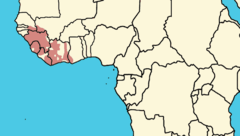Western chimpanzee
| Western chimpanzee[1] | |
|---|---|
| Conservation status | |
| Scientific classification | |
| Kingdom: | Animalia |
| Phylum: | Chordata |
| Class: | Mammalia |
| Order: | Primates |
| Family: | Hominidae |
| Genus: | Pan |
| Species: | P. troglodytes |
| Subspecies: | P. t. verus |
| Trinomial name | |
| Pan troglodytes verus Schwarz, 1934 | |
 | |
The western chimpanzee, or West African chimpanzee,[2] (Pan troglodytes verus) is a subspecies of the common chimpanzee. It inhabits western Africa, mainly in Côte d'Ivoire and Guinea but with populations in surrounding countries.
Etymology
Pan is derived from the Greek god of fields, groves, and wooded glens, Pan. Troglodytes is Greek for 'cave-dweller', and was coined by Johann Friedrich Blumenbach in his Handbuch der Naturgeschichte (Handbook of Natural History) published in 1779. Verus is Latin for 'true', and was given to this subspecies in 1934 by Ernst Schwarz.[3] Originally Schwarz classified it as Pan satyrus verus.[3]
Classification
The western chimpanzee is a subspecies of the common chimpanzee (Pan troglodytes), along with the central chimpanzee (P. t. troglodytes), the Nigeria-Cameroon chimpanzee (P. t. vellerosus), and the eastern chimpanzee (P. t. schweinfurthii).[4] They became genetically different from other chimpanzee subspecies approximately 500,000 years ago.[5]
Distribution and habitat
The population of the western chimpanzee once spanned from southern Senegal all the way east to the Niger River.[2][6] Today, the largest populations are found in Côte d'Ivoire[6] and in Guinea.[2] Other populations survive in Liberia, Sierra Leone, and Guinea-Bissau. Relict populations live in Ghana, Senegal, and Mali.[6] The subspecies is extinct in the wild in the Gambia, and possibly Benin, Burkina Faso, and Togo.[2][6]
Conservation status
The IUCN lists the western chimpanzee as an endangered species on their Red List of Threatened Species.[2] There are an estimated 21,300 to 55,600 individuals in the wild.[2] The primary threat to the western chimpanzee is habitat loss,[2] although it is also killed for bushmeat.[1]
Unique behavior
Western chimpanzees have unique behavior never observed in other species of chimpanzees. They make spears to hunt other primates, they use caves as homes, share plant foods with each other, travel and forage during the night, and submerge themselves in water and play in it.[5][7][8]
References
- ↑ 1.0 1.1 "Western chimpanzee". Panda.org. World Wide Fund for Nature. 29 May 2007. Retrieved 9 March 2009.
- ↑ 2.0 2.1 2.2 2.3 2.4 2.5 2.6 2.7 Humle, T., Boesch, C., Duvall, C., Ellis, C.M., Farmer, K.H., Herbinger, I., Blom, A. & Oates, J.F. (2008). Pan troglodytes ssp. verus. In: IUCN 2008. IUCN Red List of Threatened Species. Retrieved 9 March 2009.
- ↑ 3.0 3.1 Angela Meder (December 1995). "Men who named the African apes". Gorilla Journal (Germany) (11). Retrieved 9 March 2009.
- ↑ Hof, Jutta; Sommer, Volker: Apes Like Us: Portraits of a Kinship, Edition Panorama , Mannheim 2010, ISBN 978-3-89823-435-1, p. 114.
- ↑ 5.0 5.1 Last, Cadell (1980-05-19). "Are Western Chimpanzees a New Species of Pan? | Guest Blog, Scientific American Blog Network". Blogs.scientificamerican.com. Retrieved 2012-12-13.
- ↑ 6.0 6.1 6.2 6.3 "Western chimpanzee - Population & Distribution". Panda.org. World Wide Fund for Nature. 1 June 2007. Archived from the original on 2009-04-25. Retrieved 9 March 2009.
- ↑ "Almost Human - National Geographic Magazine". Ngm.nationalgeographic.com. 2012-05-15. Retrieved 2012-12-13.
- ↑ National Geographic video footage of behavior
External links
| ||||||||||||||||||||||||||||||
| ||||||||||||||||||||

